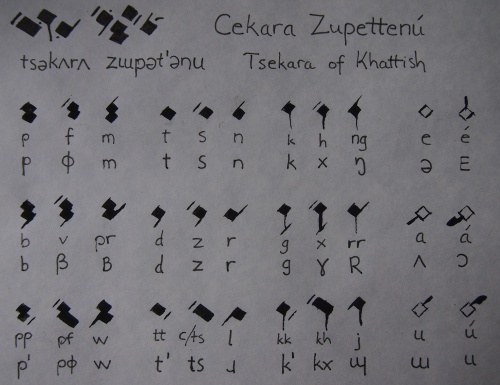Khattish
This article is a construction site. This project is currently undergoing significant construction and/or revamp. By all means, take a look around, thank you. |
Khattish Zupett [zɯpət'] is the language of Khat region in Grundet. Khattish derives from Proto-West-Herookuan languages. Although Khattish is a cousin language of Sceptrian, the strong influence from Kher languages has made it hard to recognize the shared traits.
Phonology
Consonants
The IPA symbol is shown after the romanization if they aren't the same.
| Bilabial | Alveolar | Postalveolar | Velar | Uvular | ||
|---|---|---|---|---|---|---|
| Nasal | m | n | ng ŋ | |||
| Plosive | Voiceless | p | t | k | kg q | |
| Voiced | b | d | g | gg ɢ | ||
| Fricative | Voiceless | f ɸ~f | s | ss ʃ | h x | |
| Voiced | v β~v | z | zz ʒ | x ɣ | ||
| Ejective | pp p' | tt t' | kk k' | |||
| Affricate | pf pɸ | c t͡s | cc t͡ʃ | kh kx | ||
| Trill | pr ʙ | r | rr ʀ | |||
| Approximant | w w~ʋ | l ɹ~l | j ɰ~j | |||
- /f/, /v/ and /ʋ/ are allophones of /ɸ/, /β/ and /w/ with close vowels
- /l/ and /j/ come with front vowels while /ɹ/ and /ɰ/ are used with back vowels
Vowels
| Front | Central | Back | ||
|---|---|---|---|---|
| Close | Unrounded | u ɯ | ||
| Rounded | ú u | |||
| Mid | é e | e ə~ɵ | ||
| Open-mid | Unrounded | a ʌ | ||
| Rounded | á ɔ | |||
- 'vowels can be long: aa /ʌ:/, áa /ɔ:/
- Native abjad
- /ɵ/ appears as an allophone of /ə/ after voiced consonants
Phonotactics
Word-final schwa is not pronounced
Orthography
Formal Khattish uses featural abjad script Cekara shown above with its romanization. Diacritics are marked in educational materials and words out of context, sometimes in place names as well. The diacritics have evolved into elaborate decorations in the Razáfian calligraphy.
There is some controversy of the creator of Khattish script due to loss of historical records during the years of : Lightlisteners name shinesharer saint Gunda Tliwirshu as the designer, based on the remaining parts of his chronicles written on the island of Guard already in the third era, around 470. They claim that she had to create a translation of the Book of Light and even a new script "for those living in the darkness; poor natives to whom, alas, our beautiful language (Rinapri) is nothing but dog's bark". As the language has changed much during these millennia, supporters of the Lafan school believe that the script was coined in 4th era around year 400 by Narrif Tsero, one of the most productive Khat linguists, who used Kher and Northern runic scripts (not used anymore) as the base. The new script managed to spread just in time before the decline of Khat culture and was finally revived after the of the collapse of Western Tyranny in the sixth era more than two thousand years later by Teke Kále. Much later, in the seventh era 290, the founder of New Khat Empire, Sekkute I, used the script as a national romantic example of pure Khattish culture, not contaminated by this Westlang.
See also the modern script whose one variation uses β-grapheme for v and its left-mirrored version for f, 8-grapheme for pf, b-grapheme for z and d-grapheme for s.
Morphology
- roots slightly similar to semitic roots: voiceless bi- and triliterals (while Kher have quadriliteral roots)
- voicing & ejective→affricate as one derivation process: √p-p → b-p and p-b
- derivation with affixes as well
Pronoun
Noun
Animate (AN) and inanimate (IN) grammatical genders, singular and plural numbers
Noun cases:
- Absolutive (ABS): Subject of intransitive verbs and direct object of transitive ones
- base form
- Ergative (ERG): Agent of transitive verbs
- final é
- Dative (DAT): Indirect objects and beneficials
- final k with AN and ee with IN
- Genitive (GEN):
- final l with AN and j with IN
- Locative (LOC):
- final h
- Causative (CAU):
- final f
Adjective
Verb
Apposition
postpositions
Numeral
decimal base
Syntax
ergative-absolutive alignment, word order SOV (verb-final), head-medial

